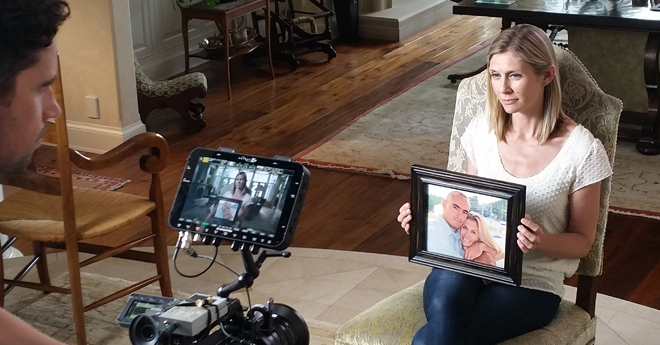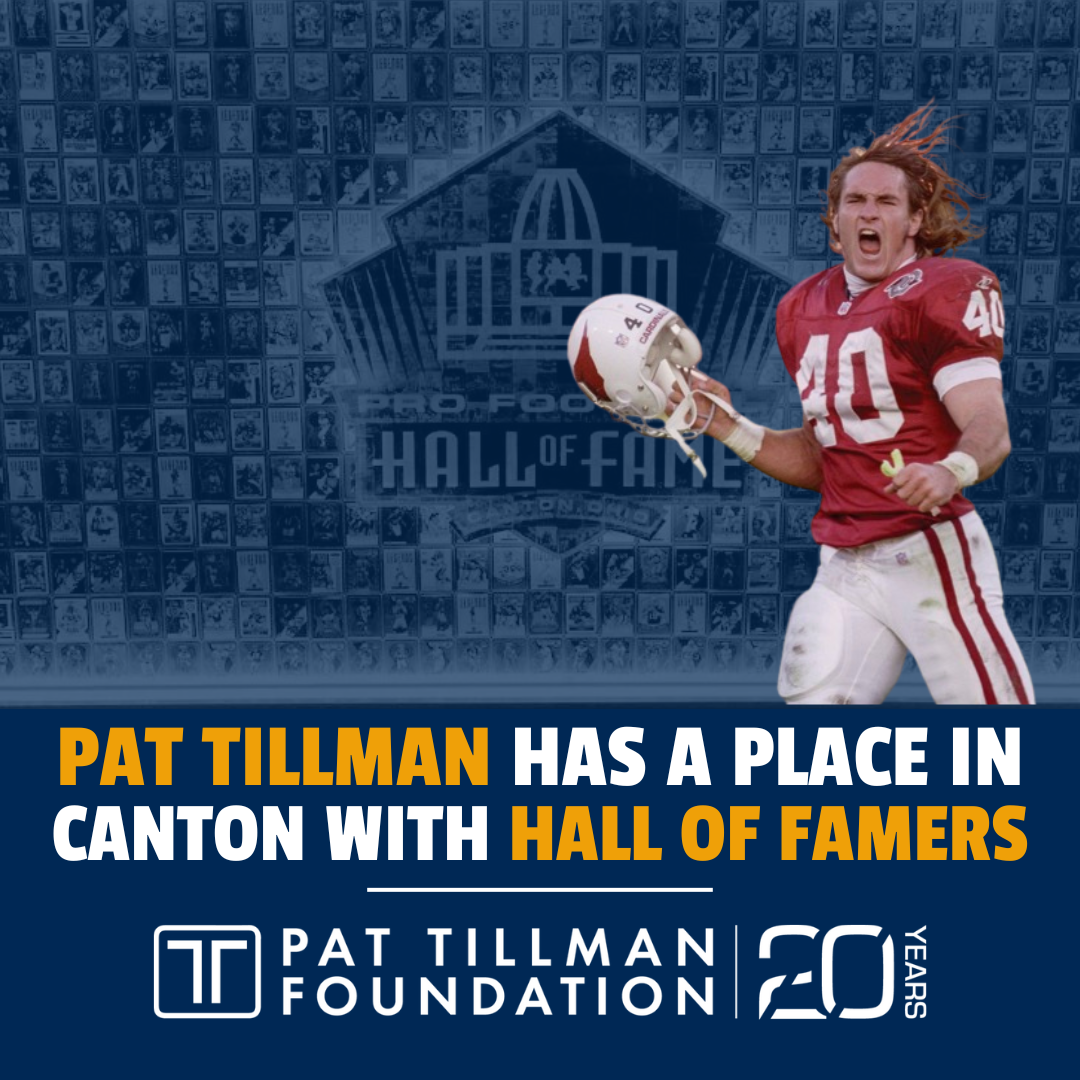TILLMAN TUESDAY: The Making of A Football Life
Pat Tillman Foundation can’t fulfill its mission to empower military veterans and their spouses without the generosity of our supporters across the country. Nationwide, over 400 Tillman Scholars are striving to impact our country and communities through their studies in medicine, law, business, policy, science, education and the arts. Every “Tillman Tuesday,” we are committed to highlighting the impact the Pat Tillman Foundation is making in the world. The sixth season of NFL Network’s Emmy-nominated series A Football Life Presented by Gillette profiled late Arizona Cardinal and Army Ranger Pat Tillman. The one-hour show produced by NFL Films’ Steve Menzel and Paul Monusky (@monuskyp) tells the story of Pat’s remarkable life from his decision to play football in high school to enlist in the Army Rangers. The impact of his legacy transcends the sports world and is aptly shown in this documentary by the growth of Pat’s Run and the impact of the Tillman Scholars. This week we were fortunate to sit down with Menzel and Monusky to learn about the decision-making and challenges faced behind the scenes while creating A Football Life. Menzel has worked for NFL Films since 2004 while Monusky has been there since 2007.
HOW DID NFL FILMS DECIDE TO FEATURE PAT’S STORY IN THE SIXTH SEASON OF ‘A FOOTBALL LIFE’?
(Steve): “Every year a long list gets narrowed down to a short list and throughout the years Pat’s name has been one of those that always kept coming up. We put together what that would look like over a six segment show and a formal way to tell Pat’s story. Once put it to paper our bosses at NFL Films could put together a show that did Pat’s story justice.”
HOW LONG HAS PAT’S FOOTBALL LIFE FEATURE BEEN IN THE MAKING?
(Paul): “We were assigned to it in March 2016 and started kicking around ideas on what we would do, who we would interview, etc. With the race being on April 23 it made things immediate if we were going to do it. Working with the people at the foundation, we tried to coordinate if we could film the race and we arranged to shoot it with nine crews over four different locations. Once we had the Pat’s Run footage we then began with the rest of the film.”
WHAT WAS THE BIGGEST CHALLENGE IN MAKING THIS FILM?
(Steve): “I think without a doubt it was having only 43 minutes of content time to tell Pat’s story, which seemed daunting at first. Looking back now we could have done two, maybe three shows if we really blew out all the story lines we had on paper. For us it was making sure we gave a balanced portrayal of Pat throughout his entire football life and his post-football life as well.”
(Paul): “The biggest challenge for me was that I felt a real responsibility to him because he was not here and he can’t tell his own story. We had other people that tried to fill in the blanks for us to kind of portray Pat as an actual human being. He only played in 60 games in the NFL and never scored a touchdown so to make his football stuff interesting and his personality interesting until you get him to the Army. Everyone wants to hear about the guy that quit the NFL and joined the Army – that’s easy but to get you to care about this person at that point was a big challenge.”
WAS HAVING YOUR BOSSES AGREE TO FEATURE PAT’S STORY A HARD SELL FOR YOU?
(Steve): “I think once we had a fairly detailed plan in place as far as what we wanted to do and what we wanted to focus on initially, they saw there was enough material put together. Once we started talking to people and interviewing them, all these stories came up and then the hard part became what we have to keep and what we can let go of. The letting go process was pretty tough.”
FOR THOSE WHO HAVE NEVER INTERVIEWED OR BEEN INTERVIEWED ON CAMERA FOR A FILM, HOW LONG WERE INTERVIEWS COMPARED TO HOW MUCH YOU ACTUALLY USED?
(Paul): “We interviewed 24 people for the film and every interview was at least 45 minutes on average with Marie’s interview being 90 minutes with two cameras. We had to log every single interview and with Pat only playing 60 games in the NFL, we went through every single game of footage which included different camera angles on different networks for all of his games to make sure we got the best footage we could.”
(Steve): “We also have a very sophisticated search engine for NFL Films footage from about 2004 on while anything prior to that is hit or miss. Part of that process all spring and summer was going through that footage and finding a lot of clips that would have gone unnoticed and that people have never seen before so it was worth it.”
(Paul): – “We had to get some footage from other stations of the clips in which he was fighting and the little things like announcers voices that we used who were talking about him – none of that stuff is logged and we just had to go through games hoping he made a tackle.”

APPROXIMATELY HOW MANY HOURS DID YOU SPEND ON JUST THIS FILM AND HOW IT WAS A CHALLENGE COMPARED TO OTHER FILMS LIKE THE BRETT FAVRE FILM?
(Paul): “If you’re doing A Brett Favre football life you know you’re going to have the ’96 Super Bowl footage and have him throwing a touchdown to Andre Rison. You also know you have him as a Viking and a New York Jet. When we started Pat’s film, there’s no signature Pat play so we really had to try and go find the best thing without leaving anything on the wayside. Whereas players like Brett Favre, Jerry Rice or Joe Montana have these tent pole football moments. I feel my co-producer Steve did a really great job highlighting the Arizona State vs. Nebraska game because that was a great football moment for Pat.”
HOW MANY MILES DID YOU TRAVEL FOR THIS PARTICULAR FILM AND COULD YOU PUT THAT INTO PERSPECTIVE?
(Steve): “We traveled a lot throughout the spring and summer but at NFL Films we also have a really good talent relations department coordinate interviews where if talent is in a certain city or sitting down with a certain player or coach, we could pick up on some different interviews and have three or four questions asked on our behalf. For example, Bill Belichick wasn’t an interview Paul or I went to – he does an annual sit down with a film producer so we put forward three questions and two of them were in the final piece.”
(Paul): “I flew enough this summer going to Arizona (three times) California and Chicago a couple of times that I was able to attend a friend’s wedding in LA for free because I had enough miles, which I did not have before we got assigned the show.”
WHETHER IT’S SOMETHING ABOUT THE FOUNDATION, THE SCHOLARS, OR PAT, WHAT IS SOMETHING YOU LEARNED THROUGHOUT MAKING THIS FILM THAT YOU MAY NOT HAVE KNOWN BEFORE?
(Paul): “People talk about legacy and leaving your mark. The foundation is Pat’s legacy but it’s the scholars you meet. Alex Garwood said it best, ‘If you want to learn about a Tillman Scholar, you ask the Tillman Scholar next to them because they never talk about themselves. The more scholars you meet, the more you realize how much they really embody Pat and learn about him. It’s amazing the foundation has been able to find these people. It’s not a political thing or an Armed Forces thing, the foundation is just able to find these individuals who are really carrying on Pat’s legacy by what they’re doing. Pat’s legacy is amazing and that is one of the coolest things. He became such an icon living only 27 years. As highly as I’ve thought about Pat prior to working on the film, I think even more of him now.”
(Steve): “Our goal going into the film was to really humanize him. We get the visual of the statue outside of the Cardinals’ stadium but our goal was to really bring him to life. We never hear him speak to the media. He was cordial with the media but never really sat down with them so for us to tell stories and anecdotes – his voice kind of resonated. Pat is the one guy that we regret not having had the opportunity to sit down and interview for five minutes. The more we researched, the more greater appreciation I have for who he really was.”
IF PAT WAS HERE TODAY AND YOU GUYS WERE DOING THE FOOTBALL LIFE WITH HIM HERE NOW, HOW WOULD YOU GO ABOUT DOING SO?
(Paul): “This is my seventh one and everyone has been really different. The end of the film is always about what they are doing now and that’s why the foundation and run were so important to us because that’s his ‘what am I doing now’ moment. Sometimes it’s four or five trips where you shoot seasons of their life and whatever they’re doing whereas sometimes players are not receptive and you just get a two-hour interview and that’s it. There’s always different challenges not having the player themselves.”
WITH THIS BEING THE SIXTH SEASON OF ‘A FOOTBALL LIFE’, HOW DOES PAT’S STORY COMPARE TO THE OTHER STORIES YOU HAVE DONE?
(Steve): “From the series as whole, we’ve told the story of 60+ unbelievable players who have a great NFL legacy but I don’t know if there’s anybody with a rich off-field life as Pat. There’s a lot of great players whose lives we have documented but I don’t know if they’ve had the depth that Pat had.”
(Paul): “Out of all of the 60+ Football Life documentaries, this is the one you want to show your kids.”
IS THERE AN ELEMENT TO THE PIECE THAT YOU WISH YOU HAD THAT YOU DIDN’T THAT COULD HAVE ADDED TO THE PIECE?
(Paul): “There were incidents that teammates told that happened at practice that were great stories that I wish we had coverage of. There weren’t a lot of cameras at Cardinals’ practices so there were at least half a dozen stories about what Pat was doing at practice that we had no coverage of and as a result hard to put in the film.”




